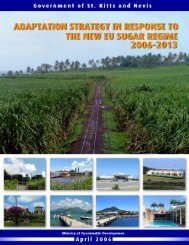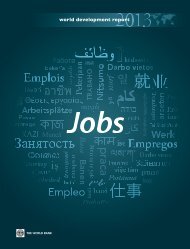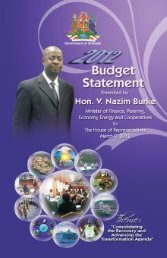Business Removing
Doing Business in 2005 -- Removing Obstacles to Growth
Doing Business in 2005 -- Removing Obstacles to Growth
- No tags were found...
Create successful ePaper yourself
Turn your PDF publications into a flip-book with our unique Google optimized e-Paper software.
ENFORCING CONTRACTS 65<br />
Two types of reform have worked. First, in Finland,<br />
Ireland and Sweden, a state enforcement authority collects<br />
all debt, including what is due in taxes. Armenia, Estonia<br />
and Latvia recently adopted a similar system. The<br />
second option is to privatize the enforcement process.<br />
In France, a private enforcement specialist, huissier de<br />
justice, collects on all private claims. 21 Belgium and the<br />
Netherlands also have private enforcement, as do many<br />
former French colonies, such as Algeria and Benin. Inspired<br />
by the French example, Hungary, Poland, Scotland<br />
and Slovakia have all introduced private enforcement.<br />
And in many common law countries—Australia, Canada,<br />
New Zealand, Uganda—the creditor’s attorney is responsible<br />
for enforcement, with the help of the police.<br />
Better incentives for remuneration—as when the enforcer<br />
is paid a percentage of the recovered claim, or<br />
a nominal fee plus a pro-rated bonus—speed up collection.<br />
22 These schemes are superior to a flat fee or wages<br />
(figure 8.7). Russia is a recent example of reform. In 2002,<br />
the remuneration rules for bailiffs were changed so that a<br />
bailiff would receive a bonus of 2% of the debt claim if he<br />
successfully collected the money. This change improved<br />
small debt recovery and had a lesser, but still positive, effect<br />
on collecting larger debts. The reason is that the<br />
bonus was capped at 800 rubles ($27), so the bailiff gets<br />
the same reward for all cases of 40,000 rubles or more. As<br />
larger amounts are more difficult to collect, enforcement<br />
focused on the easier cases. 23<br />
Finally, a reform that usually fails: increasing the<br />
number of judges to reduce court congestion. Such reform<br />
has obtained strong support in the development<br />
FIGURE 8.6<br />
Courts take longer to enforce a judgment<br />
Days between judgment and enforcement<br />
Court<br />
enforcement<br />
time<br />
Private or<br />
specialized<br />
public<br />
enforcement<br />
time<br />
Poor<br />
countries<br />
–15%<br />
Source: Doing <strong>Business</strong> database.<br />
Middle income<br />
countries<br />
–25%<br />
Rich<br />
countries<br />
–39%<br />
aid community. 24 This is understandable: by simple<br />
arithmetic, the more the judges, the fewer cases per<br />
judge. And it works for a brief period, after which delays<br />
increase again as more people bring cases to court, while<br />
the efficiency of dealing with each case remains the same.<br />
Sri Lanka is an example. To take the burden off the<br />
regular civil courts, specialized tribunals have been created<br />
to hear tax disputes, consumer complaints, and<br />
labor cases. But the civil courts remain as backlogged as<br />
ever. This is because the solution—more judges—treats<br />
the manifestation of the problem, not the problem itself.<br />
A simple rule for reformers: when the judiciary<br />
argues for more judges, it is time to also simplify procedures.<br />
It costs less and has longer term effects.<br />
Why reform?<br />
The fewer procedures, the lower the cost, the shorter the<br />
time to resolve disputes—the better that businesses rate<br />
the efficiency and integrity of the courts (figure 8.8) and<br />
the more likely that businesses are to go to the judge the<br />
next time a dispute arises. As confidence in dispute resolution<br />
rises, entrepreneurs become more willing to<br />
enter contracts beyond their narrow circle of known<br />
business partners. Trade increases and business expands,<br />
bring-ing more prosperity. A survey of Russian<br />
entrepreneurs shows that twice as many entrepreneurs<br />
start business in cities like Taganrog, where the courts<br />
are perceived as efficient, as in cities like Rostov-on-<br />
Don, where courts are perceived as corrupt and slow. 25<br />
A study comparing the corporate sectors in Mexico<br />
and the United States finds that weaknesses in contract<br />
FIGURE 8.7<br />
Payment incentives for enforcers cut time<br />
Days between judgment and enforcement<br />
Enforcer<br />
paid fixed fee<br />
Enforcer paid<br />
pro-rated fee<br />
178<br />
104<br />
Poor<br />
countries<br />
Source: Doing <strong>Business</strong> database.<br />
151<br />
82<br />
Middle income<br />
countries<br />
89<br />
29<br />
Rich<br />
countries

















